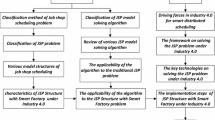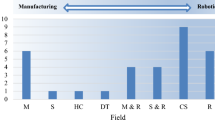Abstract
In view of the lack of efficient coordination of interdependent task in the collaborative design system, the mechanisms for temporal and resource coordination problems are established based on Petri Nets, respectively. Both of the mechanisms are encapsulated and implemented in the coordination component so as to increase the flexibility and acceptability of the system. We model the CSCW system based on Petri Nets for simulation, analysis and optimization. A case study on the overhead traveling crane is given to demonstrate and validate our theory.
Similar content being viewed by others
References
Benford, S., Snowdon, D. and Brown, C, etc., 1997, “Visualizing and Populating the Web: Collaborative Virtual Environment for Browsing, Searching and Inhabiting Web Space,”Computer Networks and ISDN Systems, Vol. 29, pp. 1751–761.
Cockburn, A. and Jones, S., 1995, “Four Principles of Groupware Design,”Interacting with Computers, Vol. 7, No. 2, pp. 195–210.
Kan, H. Y., Duffy, V. G. and Su, Chuan-jun, 2001, “An Internet Virtual Reality Collaborative Environment for Effective Product Design,”Computers in Industry, Vol.45, pp. 197–213.
Kamel, N. N. and Davison, R., 1998, “Applying CSCW Technology to Overcome Traditional Barriers in Group Interactions,”Information & Management, Vol.34, pp. 209–219.
Monplaisir, L., 1999, “An Integrated CSCW Architecture for Integrated Product/Process Design and Development,”Robotics and Computer Integrated Manufacturing, Vol. 15, pp.145–153.
Kvan, Thomas, 2000, “Collaborative Design: What Is It?”Automation in Construction, Vol.9, pp. 409–415.
Park, H. W., Kim, M. S. and Choi, D. H., 2002, “A New Decomposition Method for Parallel Processing Multi-Level Optimization,”The Korean Society of Mechanical Engineers, Vol. 16, No. 5, pp. 609–618.
Park, H. W., Lee, S. J. and Lee, H. S., etc., 2004, “Adaptive Parallel Decomposition for Multidisciplinary Design,”The Korean Society of Mechanical Engineers, Vol. 18, No. 5, pp. 814–819.
Raposo, A. B., Cruz, A. J. A. and Adriano, C. M., etc., 2001, “Coordination Components for Collaborative Virtual Environments,” Computers & Graphics, Vol. 25, pp. 1025–1039.
Raposo, A. B., Magalhaes, L. P. and Ricarte, I. L. M., etc., 2001, “Coordination of Collaborative Activities: A Framework for the Definition of Tasks Interdependencies,”Proceeding of 7th International Workshop on Groupware. Darmstadt: IEEE Computer Society, pp. 171–179.
Raposo, A. B., Magalhaes, L. P. and Ricarte, I. L. M., etc., 2000, “Petri Nets Based Coordination Mechanisms for Multi-Workflow Environments,”Computer Systems Science and Engineering, Vol. 15, No. 5, pp. 315–326.
Ricarte, I. L. M., Raposo, A. B. and Magalhaes, L. P., 2002, “Coordination in Collaborative Environments-A Global Approach,”7th International Conference on Computer Supported Cooperative, Rio de Janeir, pp. 25–30.
Rosenman, M. and Wang, Fu-jun, 2001, “A Component Agent Based Open CAD System for Collaborative Design,”Automation in Construction, Vol. 10, pp. 383–397.
Shirmohammadi, S. and Georganas, N. D., 2001, “An End-to-End Communication Architecture for Collaborative Virtual Environments,”Computer Networks, Vol. 35, pp. 351–367.
van der Aalst, W. M. P., van Hee, K. M. and Houben, G. J., 1994, “Modeling and Analyzing Workflow Using a Petri Net Base Approach,”Proceeding of 2nd Workshop on Computer-Supported Cooperative Work, Petri Net and Related Formalisms, pp. 31–50.
Wang, Hui-fen and Zhang, You-liang, 2002, “CAD/CAM Integrated System in Collaborative Development Environment,”Robotics and Computer Integrated Manufacturing, Vol. 18, pp. 135–145.
Xu, X.W. and Liu, Tony, 2003, “A WebEnabled PDM System in a Collaborative Design Environment,”Robotics and Computer Integrated Manufacturing, Vol. 19, pp. 315–328.
Author information
Authors and Affiliations
Corresponding author
Rights and permissions
About this article
Cite this article
Huang, HZ., Feng Zhou, X.Z. Petri nets based coordination component for CSCW environment. J Mech Sci Technol 19, 1123–1130 (2005). https://doi.org/10.1007/BF02984034
Received:
Revised:
Issue Date:
DOI: https://doi.org/10.1007/BF02984034




